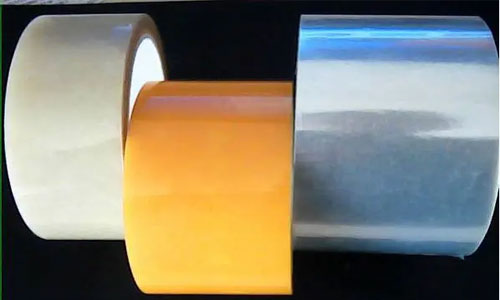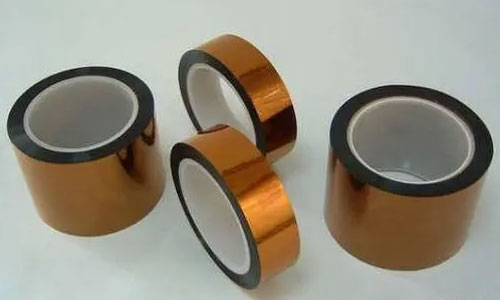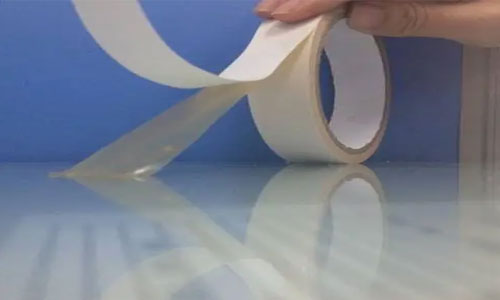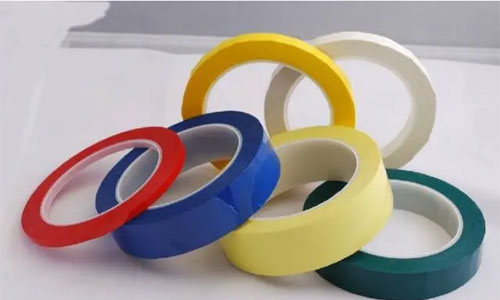Pressure sensitive adhesive is a viscoelastic material that simultaneously possesses the properties of liquid viscosity and solid elasticity. This viscoelastic material has the properties of "withstanding the influence factors and nature of both the adhesive contact process and the destructive process." Due to its dry and permanent adhesiveness, pressure sensitive adhesive is often referred to as non-drying adhesive. Its characteristics include "easy to stick, hard to peel off, and leaves no residue."
The quality of die-cutting pressure sensitive adhesive materials is influenced by various factors such as die-cutting method, precision of die-cutting equipment, precision of the die, and the compatibility between the die and the material. In addition, the die-cutting quality is also related to the characteristics of the pressure sensitive adhesive material, such as the substrate, adhesive, and release liner properties. Different types of pressure sensitive adhesive materials have different die-cutting characteristics.

Next, we will introduce the impact of the substrate, adhesive, and release liner on the quality of die-cutting of pressure sensitive adhesive materials.
Substrate’s Impact on Die-Cutting
The main factors affecting the quality of die-cutting are the type, strength, and thickness of the substrate.
1. Type of Substrate
The substrate can be divided into two main categories: paper and film. The cutting principles for paper substrates are slightly different from those for film materials. Based on the die-cutting characteristics of paper materials and considering the wear of the blade, the angle of the flat-to-flat die-cutting blade is usually set at 52 degrees. A large angle increases the material's extrusion deformation, causing the horizontal separation force to exacerbate material fracture and separation.
For die-cutting film materials, it is essentially a complete cutting process. Because most film materials have toughness and do not naturally break, it is not suitable to cut two-thirds of the thickness. It must be fully or four-fifths cut, otherwise, the waste removal will cause the product to peel off.
The blade for die-cutting film materials needs to be sharp and have high hardness. A small angle die-cutting blade is usually set at an angle of 30° to 42°. Using a large angle die-cutting blade not only makes die-cutting difficult but also leads to the inability to cut the substrate and the release liner or causes the edges of the die-cut product to curl, resulting in adhesive leakage.
In summary, the precision of die-cutting film materials needs to be higher than that of paper materials. Therefore, die-cutting film materials require a certain level of equipment precision, die precision, and release liner quality.

2. Strength of Substrate
The strength of the substrate is related to the thickness, fiber (polymer) structure, and its moisture content. During the die-cutting process of pressure sensitive adhesive materials, the most significant factor associated with the substrate is the waste removal speed. The higher the environmental humidity, the weaker the material's strength after moisture absorption. This makes the material more prone to fracture or even unable to be removed as waste.
When designing the layout, it is important to arrange the size and waste removal speed of the die-cut products according to the strength of the material through empirical testing, which can not only improve production efficiency but also reduce material waste.
3. Thickness of Substrate
The thickness of the material directly affects the depth of die-cutting. Thicker materials are easier to die-cut, as the thicker the material, the larger the tolerance of die-cutting, making it less likely to cut through the release liner. Conversely, thin materials are prone to cutting through the release liner.
Therefore, when die-cutting thin substrates, it is necessary to use high-precision equipment, reduce the die-cutting area as much as possible (especially for small products), and use die-cutting tools from professional die manufacturers.
The thickness of the substrate is directly proportional to its strength and directly affects the waste removal speed. An experiment comparing 80g/m² and 60g/m² materials found that the former increased production efficiency by 20% to 30% compared to the latter.
Impact of Adhesive on Die-Cutting
Four primary types of adhesives are commonly used in pressure sensitive adhesive materials:
1. Acrylic water-based emulsion
2. Rubber-based hot melt adhesive
3. Solvent-based rubber
4. Acrylic adhesive
The most widely used adhesives are emulsion and hot melt adhesives. Due to the different raw materials and formulations of adhesives, their physical and chemical properties vary. Emulsion adhesive is composed of small capsules with low internal cohesion, making it easy for the adhesive film to separate. Hot melt adhesive, on the other hand, has a strong internal cohesion that makes it difficult for the adhesive film to separate. In die-cutting, if the adhesive layer of emulsion adhesive material is not cut or not completely cut, the label can still be removed as waste during die-cutting. Conversely, in die-cutting hot melt adhesive materials, if the die-cutting is not complete, the release liner will either tear or cut through, as only complete or largely complete cutting allows for proper waste removal. Therefore, die-cutting emulsion adhesive materials is relatively easy, while die-cutting hot melt adhesive materials requires higher die-cutting technical proficiency. This is also a major reason for the high consumption and low production efficiency of processing hot melt adhesive materials.

Impact of Release Liner on Die-Cutting
The quality of the release liner is a key factor affecting die-cutting quality. The thickness, flatness, fiber structure, and strength of the release liner directly influence die-cutting quality.
Common release liners can be divided into two main types:
1. Opaque and translucent release liners. Opaque release liners for pressure sensitive adhesive materials typically have a weight of 90g/m² and above with a certain stiffness, suitable for both sheet and roll printing, with the finished labels mostly used for manual labeling.
2. On the other hand, translucent release liners for pressure sensitive adhesive materials typically weigh between 60-70g/m² and have a certain fiber density, primarily used for roll printing and not suitable for sheet printing. The finished labels are used for automatic labeling.
Pressure sensitive adhesive materials require release liners with good flatness, uniform thickness, consistent transparency, and higher density for complete die-cutting.

1. Opaque Release Liner
Common opaque release liners are differentiated by color into yellow and white and by structure into PE-coated and non-PE-coated.
The PE-coating serves two purposes: to seal the surface pores of the paper and make it smooth and to apply silicone oil on it to reduce the coating amount, thereby reducing costs. It also improves die-cutting characteristics, as the PE coating acts as a cushion, providing some toughness and elasticity to reduce the likelihood of release liner breakage. However, in practice, PE-coated release liners have significantly lower breakage resistance compared to non-PE-coated release liners.
- Thick release liners are mainly used for manual labeling and inadequate die-cutting can affect manual labeling. If the die-cutting is incomplete, the label will be removed along with the waste paper during manual waste removal. If the liner is cut through or only halfway cut, it will be very difficult for the operator to remove the label as well.
- When die-cutting with a flat-to-flat die-cutting machine, the common fault encountered is release liner breakage. Therefore, it is important to choose release liners with good flatness, high fiber tension, and uniform thickness to improve die-cutting quality, while also ensuring the precision of die and cushioning.
2. Translucent Release Liner
Translucent release liners, also known as thin release liners, are commonly used with pressure sensitive adhesive materials and are often made of glassine release paper.
Two key indicators affecting the die-cutting quality of glassine release paper are uniform thickness and fiber structure. Uniform thickness is critically important, especially for rotary die-cutting, as the size of the die blades is determined by the thickness of the release liner, and uneven thickness can lead to cutting through or not cutting through the release liner, causing difficulties in the waste removal process.
The fiber structure of glassine release paper mainly affects the die-cutting speed in rotary die-cutting, as fiber strength directly impacts waste removal breakage speed. The greater the speed and force, the easier the waste removal. If the material itself has high strength, die-cutting speed can be increased. However, for slower flat-to-flat die-cutting, fiber structure has minimal impact on die-cutting quality.
Additionally, the toughness and breakage resistance of the fibers have a significant impact on die-cutting quality. Release paper with good fiber toughness may not present issues on equipment with low precision, whereas release paper with brittle and low toughness fibers must only be die-cut on high-precision equipment with good die-cutting quality. This indicates that the precision of the equipment is also one of the factors influencing die-cutting quality.

Key Points of Die-Cutting Technique
Various properties of pressure sensitive adhesive label materials, such as the strength of the pressure sensitive adhesive substrate, the characteristics of the adhesive, and the strength of the release liner, have a certain impact on the die-cutting quality of the label. Therefore, it is important to have specific requirements when selecting pressure sensitive adhesive materials and label processing to improve the die-cutting quality.
Through years of practice, we have summarized the problems encountered in our work and have proposed several considerations to effectively improve die-cutting quality when selecting pressure sensitive adhesive materials and label processing.
1. Do not use a die-cutting board for paper materials to die-cut film materials, as the blades are already worn and not suitable for die-cutting film.
2. During flat-to-flat die-cutting, reduce the die-cutting area as much as possible, especially for full-board small labels, as the large area and multiple cuts make it difficult to guarantee quality.
3. For flat-to-flat die-cutting, the cushioning pad should be replaced regularly, especially when processing long board activities, as cutting marks can affect the die-cutting quality of new layout labels.
4. During flat-to-flat die-cutting, ensure that the die-cutting force is just right. This requires the skills of an experienced operator and sometimes it is better to cut slightly shallower.
5. Regularly check die-cutting quality, especially for labels used for automatic labeling, to avoid large-scale quality problems. A specific checking method is to use a marker to smear on the release paper and check the penetration of the cutting marks.
6. For die-cutting large areas or complex pattern labels, it is advisable to have custom die boards made by professional manufacturers to ensure die-cutting precision.
7. Maintain sharp blades, keep records of the usage of each die board, and replace the blades promptly. Use specialized sharp blades with small angles and high hardness for die-cutting film pressure sensitive adhesive materials, especially PE materials.
Contact: Pamela
Phone: +86 189 6365 3253
E-mail: info@industryprocess.com
Whatsapp:+86 189 6365 3253
Add: Yajing Industrial Park, No. 59 Shuangjing Street, Weiting Town, Suzhou Industrial Park
We chat
